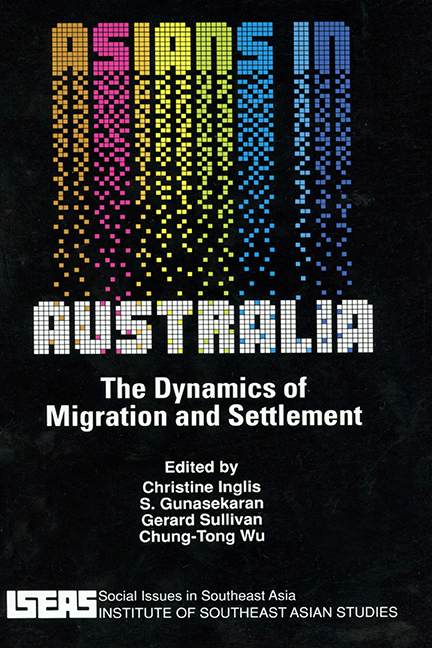Book contents
- Frontmatter
- Contents
- List of Tables
- List of Figures
- Introduction
- 1 China's Policy Towards Migrants, 1842–1949
- 2 Japanese Emigration Policy, 1880–1941
- 3 The “New” Migration and Australian Immigration Policy
- 4 Patterns of Settlement in Australia of Indochinese Refugees
- 5 Labour Market Outcomes Among the Chinese at the 1986 Census
- 6 Is There An Asian-Australian “Brain Drain”?
- 7 The “New” Migration of Asian Skills and Capital to Australia
Introduction
Published online by Cambridge University Press: 21 October 2015
- Frontmatter
- Contents
- List of Tables
- List of Figures
- Introduction
- 1 China's Policy Towards Migrants, 1842–1949
- 2 Japanese Emigration Policy, 1880–1941
- 3 The “New” Migration and Australian Immigration Policy
- 4 Patterns of Settlement in Australia of Indochinese Refugees
- 5 Labour Market Outcomes Among the Chinese at the 1986 Census
- 6 Is There An Asian-Australian “Brain Drain”?
- 7 The “New” Migration of Asian Skills and Capital to Australia
Summary
Asian immigration is not a new phenomenon in Australia, nor indeed is the tendency for it to be surrounded by political controversy. From the middle of the nineteenth century, Australia was a destination for Chinese migrants who were part of a larger wave of Chinese emigration to the countries of Southeast Asia and the Pacific basin. Together with smaller numbers of other Asian groups they are estimated to have comprised nearly 3.5 per cent of the Australian population in 1861 (Price 1983). The controversy surrounding this early migration and the eventual introduction of the “White Australia” policy as one of the first legislative actions of the new Commonwealth of Australia in 1901 are well known.
The effect of this policy was to substantially reduce the extent of non-European migration so that by 1947, when the extensive post-war immigration policy was being initiated, the Asian component of Australia's population was estimated to be less than 0.4 per cent of the total. Not until 1967, when the policy was changed to allow the entry of skilled non-Europeans, was there any significant growth in Asian migration to Australia. The decision by the Whitlam Labour government in 1973 not to discriminate against applicants for immigration to Australia on the basis of ancestry or ethnicity removed the remaining restrictions on Asian immigration. The number and proportion of immigrants from this region of the world began to increase rapidly from that point and by J9H8 Australians of Asian ancestry were estimated to once again comprise more than 3 per cent of the population (Price 1988).
The arrival of large numbers of Indochinese in the mid-1970s was the first event that focused extensive public attention on renewed immigration from Asia. More recently, the issue of Asian immigration erupted into public controversy with the so-called Blainey debate in 1984, and then in 1986, when the then leader of the federal opposition, John Howard, expressed concern about the threat to social cohesion posed by Australia's increasingly multicultural population.
- Type
- Chapter
- Information
- Asians in AustraliaThe Dynamic of Migration and Settlement, pp. xi - xviPublisher: ISEAS–Yusof Ishak InstitutePrint publication year: 1992

